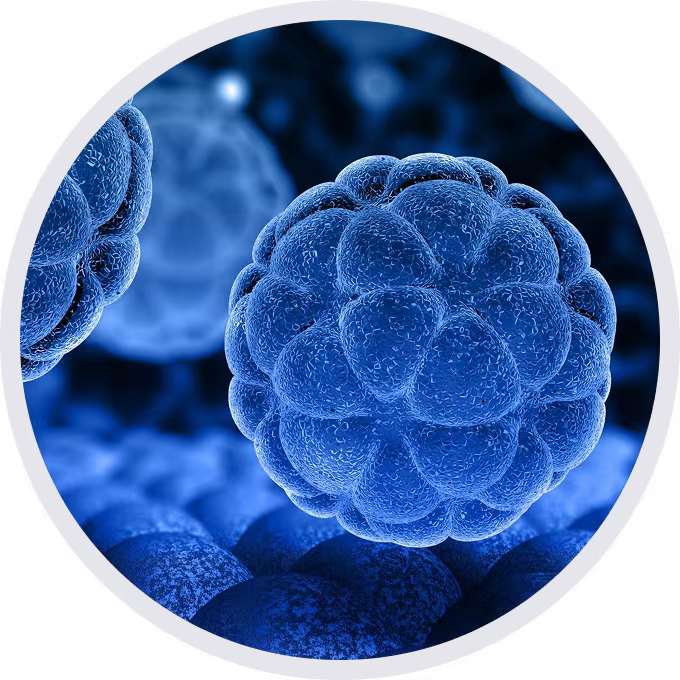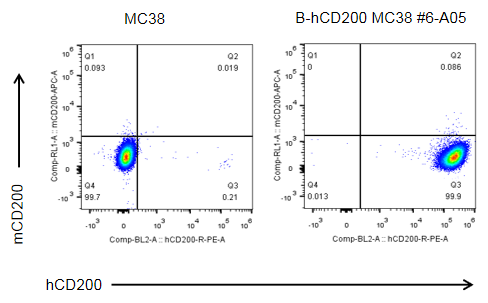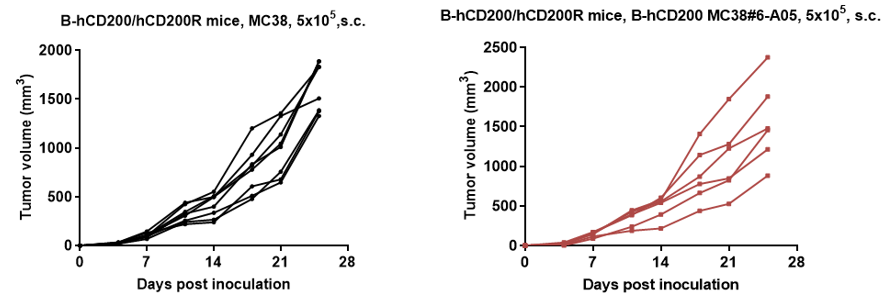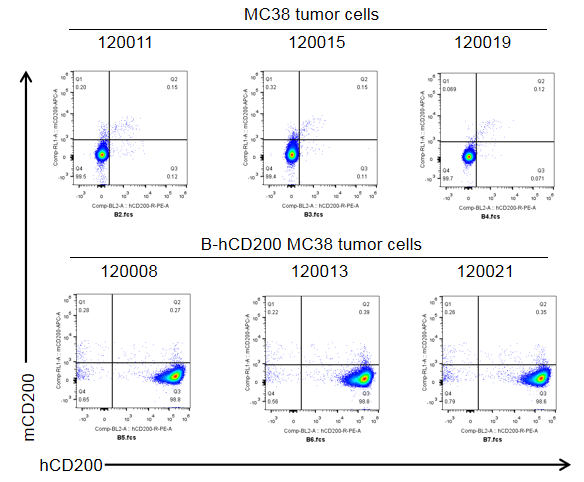


• 321839
| Product name | B-hCD200 MC38 |
|---|---|
| Catalog number | 321839 |
| Strain background | C57BL/6 |
| Aliases | CD200, MOX1, MOX2, MRC, OX-2, CD200 molecule |
| Tissue | Colon |
| Disease | Colon carcinoma |
| Species | Mouse |
| Application | B-hCD200 MC38 cells have the capability to establish tumors in vivo and can be used for efficacy studies.Note that B-hCD200 MC38 cells successfully formed tumors only in B-hCD200/hCD200R mice, but not in wild-type mice. |
on this page
The mouse Cd200 gene was replaced by human CD200 coding sequence in B-hCD200 MC38 cells. Human CD200 is highly expressed on the surface of B-hCD200 MC38 cells.

CD200 expression analysis in B-hCD200 MC38 cells by flow cytometry.
Single cell suspensions from wild-type MC38 and B-hCD200 MC38 cultures were stained with species-specific anti-CD200 antibody. Human CD200 was detected on the surface of B-hCD200 MC38 cells, but not on the surface of wild-type MC38 cells. The 6-A05 clone of B-hCD200 MC38 cells was used for in vivo tumor growth assays.

Subcutaneous homograft tumor growth of B-hCD200 MC38 cells.
B-hCD200 MC38 cells (5x105) and wild-type MC38 cells (5x105) were subcutaneously implanted into heterozygous B-hCD200/hCD200R mice (male, 7-week-old, n=6). Tumor volume and body weight were measured twice a week. (A) Average tumor volume ± SEM. (B) Body weight (Mean ± SEM). Volume was expressed in mm3 using the formula: V=0.5 × long diameter × short diameter2. As shown in panel A, B-hCD200 MC38 cells were able to form tumors in vivo and can be used for efficacy studies.
Note that B-hCD200 MC38 cells successfully formed tumors only in B-hCD200/hCD200R mice, but not in wild-type mice.

B-hCD200 MC38 tumor cells growth of individual mice.
B-hCD200 MC38 cells (5x105) and wild-type MC38 cells (5x105) were subcutaneously implanted into heterozygous B-hCD200/hCD200R mice (male, 7-week-old, n=6). As shown in panel, B-hCD200 MC38 cells were able to establish tumors in vivo and can be used for efficacy studies.
Note that B-hCD200 MC38 cells successfully formed tumors only in B-hCD200/hCD200R mice, but not in wild-type mice.

B-hCD200 MC38 cells were subcutaneously transplanted into heterozygous B-hCD200/hCD200R mice (n=6). At the end of the experiment, tumor cells were harvested and assessed for human CD200 expression by flow cytometry. As shown, human CD200 was highly expressed on the surface of tumor cells. Therefore, B-hCD200 MC38 cells can be used for in vivo efficacy studies.
Note that B-hCD200 MC38 cells successfully formed tumors only in B-hCD200/hCD200R mice, but not in wild-type mice.

Subcutaneous homograft tumor growth of B-hCD200 MC38 cells.
B-hCD200 MC38 cells (5x105) were subcutaneously implanted into homozygous B-hCD200/hCD200R mice (female, 10-week-old, n=6). Tumor volume and body weight were measured twice a week. (A) Average tumor volume ± SEM. (B) Body weight (Mean ± SEM). (C) Tumor growth curve of individual mice. Volume was expressed in mm3 using the formula: V=0.5 × long diameter × short diameter2. As shown in panel A, B-hCD200 MC38 cells were able to form tumors in vivo and can be used for efficacy studies.
Note that B-hCD200 MC38 cells successfully formed tumors only in B-hCD200/hCD200R mice, but not in wild-type mice.